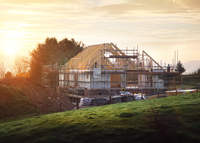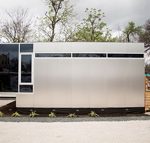The housing shortage in the U.S. is deepening despite strong demand, and a new report found that builders must construct nearly four million new homes to catch up.
Almost 9.8 million households were formed between 2012 and 2019, but just 5.9 million new single-family homes were constructed during that period, according to listings website Realtor.com.
The report found it could take four to five years to fill the void of 3.8 million homes. That estimate comes even as single-family home construction starts per 1,000 households rose to 7.3 last year from 4.6 in 2012, according to Realtor.com. The eight-year average is 6.2 starts per 1,000 households, which is under the two-decade average.
“We still have a relative lack of supply,” said Mike Fratantoni, chief economist at the Mortgage Bankers Association. “Building has just not kept up with demand for the past several years.”
Read more



Because of this deficit, the listings platform predicts existing home sales will drop 1.8 percent this year. And the group expects the median price growth of those existing homes to rise a tepid 0.8 percent.
The demand is there to build more houses. Baby boomers are not leaving their homes and millennials are increasingly starting families, said Morris Davis, real estate professor and academic director of the Rutgers Center for Real Estate in Newark.
But demand for new housing is most pronounced in and around the gateway cities, where there is ample employment, Davis said.
“I do believe places like California and, to a lesser degree New York need an injection of housing to keep up with the demand of people” moving to those areas, he said.
While the country may need to add almost 4 million homes to its inventory, other estimates have found that the need for new homes in California alone could be nearly just as much: The state needs to build between 1.8 million and 3.5 million new homes by 2025 to help tackle homelessness and soaring housing prices.
The nationwide housing shortage is nothing new.
Since 2001 the U.S. has constructed 17.6 million new single-family homes, a figure that has fallen short of the 20.2 million households that have since been created. That translates to a gulf of 2.6 million homes, according to Realtor.com.
At one point in the early 2000s, new home construction outpaced new household growth. But the financial crisis changed that, and builders pulled back. While housing starts picked up again during the economic recovery, growth has been anemic, according to Realtor.com’s report.
Zoning constraints and ballooning construction costs have hampered the construction of both single-family homes and multifamily buildings, said Richard Koss, an adjunct professor at Columbia University who also is chief research officer of mortgage fintech firm Recursion Co.
Still, there are signs that housing production could improve in 2020. Housing starts in December jumped to 1.6 million, marking a 13-year high, according to the U.S. Census Bureau and the U.S. Department of Housing and Urban Development. Just over 1 million of those starts were single-family homes.
But Koss cautioned against looking at one month’s worth of data for substantive change.
“We’ll see in the next couple of months,” he said. “We can always be surprised.”
Write to Mary Diduch at md@therealdeal.com
